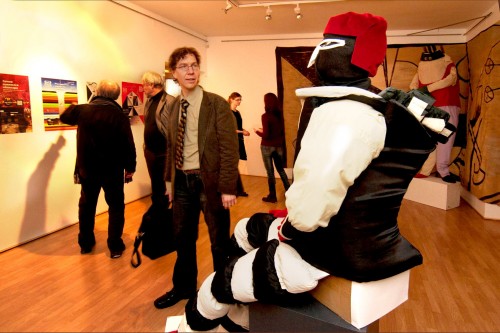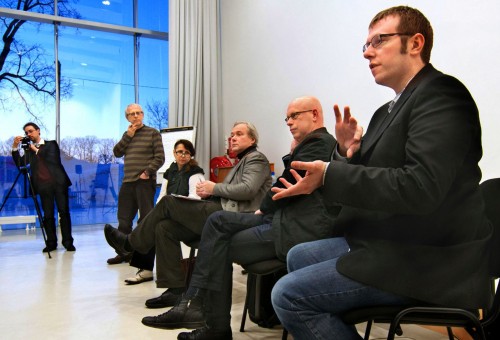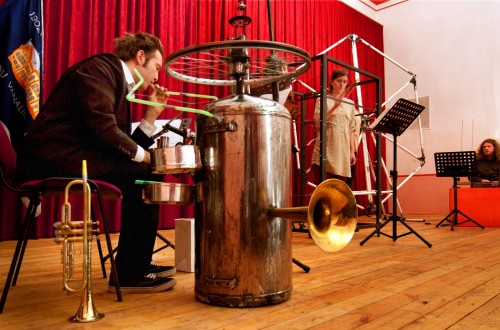Futurism as a Way of Thinking
A review by Aleksandra Dolgopolova and Gerhard Lock
International Symposium, Exhibitions, Concerts
Pärnu Days of Contemporary Music (Pärnu Nüüdismuusika Päevad)
5-13 January 2013
For more than two decades, the Estonian Arnold Schoenberg Society has been organizing the Pärnu Days of Contemporary Music. This year – building on past success – the horizon of the festival was broadened in order to introduce new topics and to appeal to a wider public. The focus in 2013 was on Futurism, and the art movement was discussed not only by musicologists, but also theater scholars, philosophers, semioticians, historians, and artists, both from Estonia and from other countries. Apart from scholars and academics also students were in attendance, mainly coming from the Graduate School of Culture Studies and Arts.
The festival was held in Pärnu, a seaside resort considered the Estonian summer capital because of its fabulous beaches, rich nightlife and trendy art scene. Pärnu is also known to Futurism scholars as the first city in the Baltics where a group of Futurists came into existence, approximately 100 years ago. The event was therefore a belated Centenary of Futurism, Baltic style, and was celebrated with a bevy of activities, including a symposium, two concerts, workshops, two exhibitions and performances.
At the symposium, entitled Tracing Futurist Ideologies – co-organized by Estonian Arnold Schoenberg Society (Andrus Kallastu, Kerri Kotta, Gerhard Lock) and the Estonian Graduate School of Culture Studies and Arts, with support from the European Union Social Fund and the Goethe Institute – the focus was not just on the history of Futurism but also on the movement’s influence on the present. The keynote address was given by Günter Berghaus (University of Bristol), who spoke about The Futurist Fusion of Art, Life and Politics and discussed the movement’s complex relationship with the political situation that existed in Italy at the beginning of the twentieth century. He demonstrated the Futurists’ interest in radical politics and spoke about their connections with Anarchism, Bolshevism, and Mussolini’s Fascism. He also presented the first two volumes of the International Yearbook of Futurism Studies, which he set up in 2009 to offer opportunity for publishing essays and articles concerned with the international dimension of the Futurist movement, and to foster intellectual cooperation between Futurism scholars across countries and academic disciplines.
Futurism in the early twentieth century was a lively and stimulating force in the political, social and artistic domains. Many of its utopian ideas and projects were never fully realized, as was demonstrated by Edward Venn (Lancaster University) in his presentation, Ghosts in the Machine, and the Machine’s Ghosts: The Present Pastness of Futurism. Taking recourse to Derridean hauntological precepts, he argued that the very rejection of tradition served Marinetti and his followers to inscribe it all the more forcibly in those places where it was superficially rejected. He demonstrated some present invocations and echoes (intentional or otherwise) of Futurist ideologies in the music of Harrison Birtwistle and the 2012 Olympic Opening Ceremony in London.
The second part of the day was made up of presentations of artistic research conducted by doctoral students from Estonian Academy of Music and Theatre in Tallinn (Christian M. Fischer on Motion Graphics, Musical Notation: An Example of the Topicality of Futurist Concepts; Arash Yazdani on The Musical Study of Future: Importance and Application of Music Acoustics on Education in Music; Hans-Gunter Lock on The Art of Noises and Acoustic Concepts of Sound and Noise). Connecting theme of their papers was the Futurist Way of Thinking. Artistic research conducted in workshops and classrooms was closely related to the symposium’s topic, and the resulting creative work was presented in illustrated lectures, as well as performances.
At the end of the first day of the symposium, the Ensemble U gave a theatrical concert inspired by Futurist aesthetics, especially the concepts of noise, technical innovations, machines, and industrialization. Presentations included Vladimir Mayakovsky’s poem ”Small Noises, Noises and Big Noises” (Шумики, шумы, шумищи, 1913), electronically mixed by Tarmo Johannes with texts by Filippo Tommaso Marinetti, using a TouchOSC as a controller. Sounds were converted into images and projected onto a screen in a manner that the rotational movement on the iPad were imitating the rotational movement of Russolo’s intonarumori. Another form of Futurist music was represented by the Russian composer Aleksandr Mossolov (1900-1973), author of the famous Symphony of Machines “Zavod” (Завод: Музыка машин, 1928). In the concert, this piece was presented in the form of a ”democratic remix”, in which every member of the orchestra could influence the order of the fragments of the composition, and the whole sound that resulted from the operation. Apart from these Futurist examples, the concert also included the Ursonate by Kurt Schwitters (1887–1948).

The second day of the symposium started with a presentation by the theatre historian Galina Gubanova (Moscow/Vilnius) who has dedicated most of her professional life to researching the first Futurist opera, Victory over the Sun (Победа над Солнцем, 1913, music: Mikhail Matiushin, libretto: Aleksei Kruchenykh, set design: Kazimir Malevich). She discussed Malevich’s costumes and their relation with the Commedia dell’arte, and acquainted the audience with the extensive symbolic arsenal of the opera. During the Festival, the public had the opportunity to see an exhibition (open 5-25 of January at the Pärnu City Art Gallery), in which costumes and set designs from Gubanova’s production of the opera in Sankt-Petersburg were on display.
The art historian Raivo Kelomees (Estonian Academy of Arts, Tallinn) gave an extended visual presentation of examples of art inspired by the concept of a Total Work of Art. Starting with Giacomo Balla’s Abstract Speed + Sound (Velocità astratta + Rumore, 1913-14), Dynamism of a Dog on a Leash (Dinamismo di un cane al guinzaglio, 1912), Umberto Boccioni’s Unique Forms of Continuity in Space (Forme uniche della continuità nello spazio, 1913), and Natalia Goncharova’s Cyclist (Велосипедист, 1913) he continued with more contemporary examples stemming from architecture, performance, film, interactive art, virtual reality, all of which address various sensory forms of perception in an synaesthetic manner. Finally, Tiit Hennoste (University of Tartu) moderated a methodological round table discussion of the topic ”How to analyze the new?”

In the course of the day, there was an opportunity to visit a second exhibition of Futurist musical instruments that had been constructed during a workshop at the Estonian Academy of Arts led by Erik Alalooga, Andrus Kallastu and Tanja Kozlova. In the evening of 12 January in the Old Town’s Primary School, the students demonstrated how such instruments – inspired by Luigi Russolo (1885-1947), originator of the Futurist Art of Noises and inventor of the Intonarumori (Noise intoner) – could be used in a concert. The instruments carried names such as “The Wheel of the World”, “Framarr”, “Boiler”, “Excelsibur” and were not only visually intriguing, but also able to produce unusual sounds and timbres. During the concert, a further layer of allure was added by the fact that performers argued amongst themselves and sometimes left the hall in an agitated manner. However, these seemingly improvised performance elements were actually part of the score. After the presentation given by the art students followed fragments based on free interpretation of Kruchenykh’s libretto for Victory over the Sun, composed by Hans-Gunter Lock (b. 1974) using the Bohlen-Pierce scale, an alternative to the octave-based scales typical in Western music. The five movements were performed by the Repoo Ensemble and directed by PNP artistic director and composer Andrus Kallastu. In the end, a collective composition, The Way to the Future (2013) released the audience into a bitter-cold Estonian Winter night.

Taken altogether, the 2013 Pärnu Days of Contemporary Music offered a coherent series of events that focused upon some central ideas of historic Futurism. The organizers and the participants succeeded in addressing a variety of issues and artistic forms of expression, and demonstrated that Futurism was not just a “historical” avant-garde, but an all-encompassing cultural phenomenon that affected subsequent artistic developments and can still offer inspiration to young artists in our day and age.